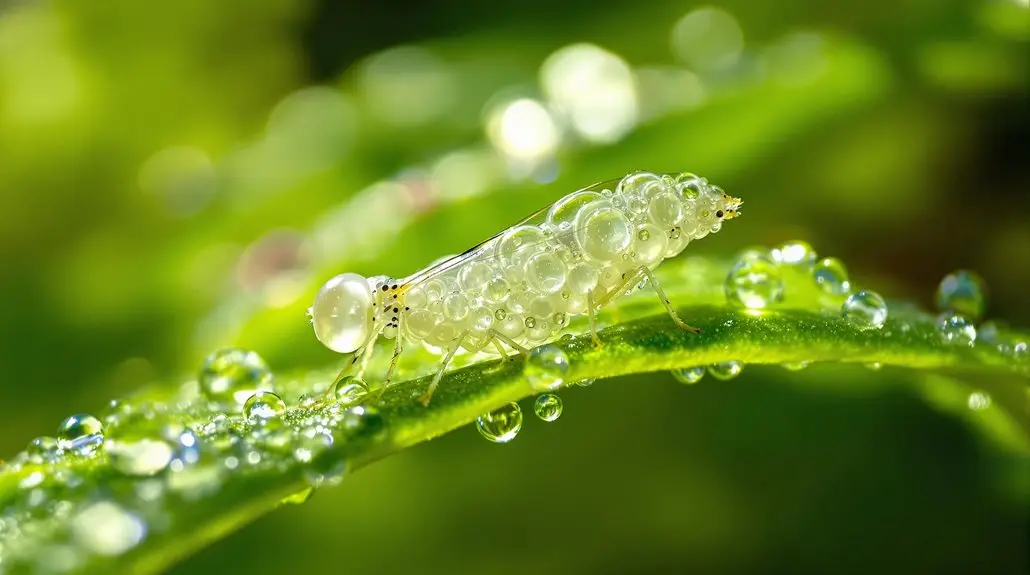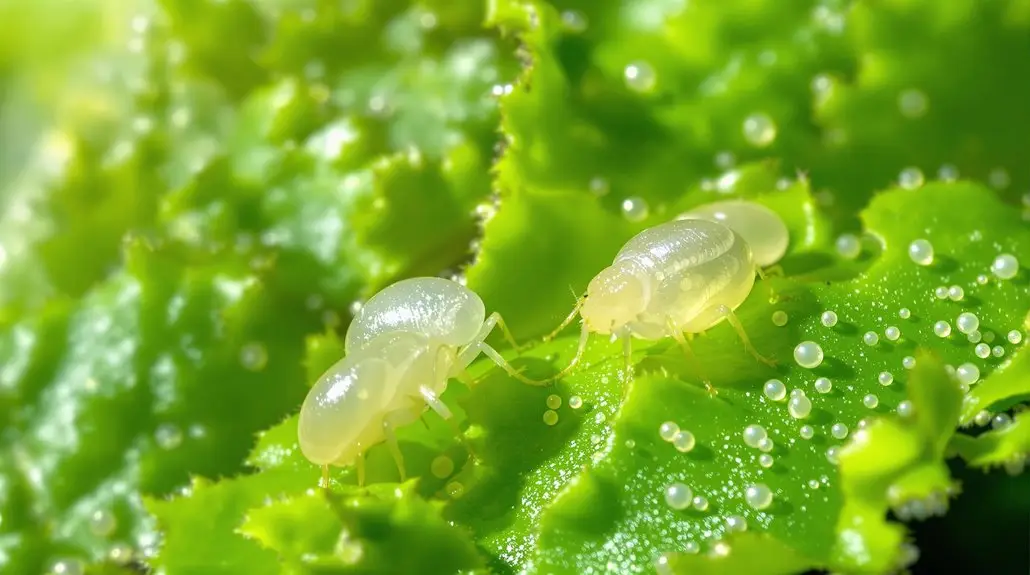South Florida Ovipos
The rugose spiraling whitefly (*Aleurodicus rugioperculatus*) exhibits distinct oviposition preferences for various host plants in South Florida, including coconut, avocado, black olive, and gumbo limbo. Research indicates that coconut and black olive are preferred for egg-laying, while gumbo limbo serves as the most favored host overall. These choices considerably influence whitefly population dynamics, affecting local agriculture and ecosystems. Further exploration reveals additional factors regarding their behavior and impacts on host plants.
Key Insights
- Rugose spiraling whitefly prefers coconut and black olive for oviposition, with gumbo limbo being the most favored host plant.
- Avocado shows moderate oviposition preference, while survival rates across all tested host plants remain consistent and adaptable.
- Egg distribution occurs in spiral patterns on the undersides of leaves, providing moisture and protection for developing eggs.
- Seasonal changes significantly influence the timing and location of egg-laying activities by the whiteflies.
- Monitoring preferred host plants is crucial for effective pest management strategies and early detection of infestations.
Overview of Rugose Spiraling Whitefly
The Rugose Spiraling Whitefly, scientifically known as *Aleurodicus rugioperculatus*, represents a significant pest species first described in 2004 from samples collected in Belize. This pest, native to Central America, was introduced to Florida, USA, where it has become problematic. Adult whiteflies measure approximately 2.5 mm, making them three times larger than common whiteflies. Importantly, these adults exhibit lethargic behavior and have distinctive wing markings. The first sighting in the U.S. occurred in Miami-Dade County in 2009, and the species has since spread mainly across southern and central Florida, impacting various counties. The movement of this pest is facilitated by climate and the availability of host plants, contributing to its ongoing distribution challenges. Recent studies have shown that the whitefly exhibits a preference for certain host plants, indicating its oviposition preference is critical for understanding its management.
Oviposition Preferences Among Host Plants
When examining the oviposition preferences among host plants for rugose spiraling whiteflies, researchers found distinct patterns in host plant selection, with gumbo limbo emerging as the most favored option. Despite variations in leaf size and surface area among the tested species, the distribution of eggs did not correlate notably with these physical characteristics, suggesting that other factors may influence laying behavior. Additionally, survival rates did not differ greatly across host plants, indicating that preference is likely driven by factors beyond mere survival. The excessive honeydew production associated with rugose spiraling whitefly feeding could also influence the oviposition preferences observed in this study.
Preferred Host Plant
While many plant species can serve as hosts for the rugose spiraling whitefly, research indicates that certain plants are preferred for oviposition, which is vital for the whitefly’s life cycle and population dynamics. A study highlighted five key host plants in South Florida, noting their specific attractiveness to the whitefly.
| Host Plant | Oviposition Preference |
|---|---|
| Coconut (Cocos nucifera) | High |
| Avocado (Persea americana) | Moderate |
| Black Olive (Bucida buceras) | High |
| Gumbo Limbo (Bursera simaruba) | High |
Understanding these preferences aids in managing and controlling whitefly populations effectively. Such insights are significant for developing integrated pest management strategies and mitigating economic impacts in urban landscapes. The rugose spiraling whitefly has been documented on more than 60 plant species, emphasizing the importance of host plant selection in pest management.
Egg Distribution Patterns
Egg distribution patterns among host plants reveal significant insights into the reproductive strategies of the rugose spiraling whitefly, particularly regarding how and where these insects lay their eggs. Typically, these elliptical, whitish to yellow eggs are deposited on the undersides of leaves in spiral or concentric patterns, providing moisture and protection. The eggs, covered with a white waxy matter, develop under ideal conditions of around 27°C, while high humidity can enhance egg survival rates. Various host plant characteristics, such as leaf texture and nutrient richness, influence oviposition preferences. Additionally, environmental factors, including seasonal changes, impact the timing and location of egg-laying, showcasing the whitefly’s adaptability to diverse conditions and host plant availability.
Survival Rates Comparison
Research examining survival rates among various host plants reveals that the rugose spiraling whitefly demonstrates remarkable adaptability, as no statistically significant differences in survival were found across the five species tested, which include coconut, gumbo limbo, avocado, black olive, and giant white bird of paradise. This adaptability highlights the whitefly’s resilience in varying environmental conditions. Notably, the egg-to-adult survival rates ranged from 5% to 10%, indicating that despite the lack of significant differences in survival across host plants, the whitefly faces challenges in its life cycle.
| Host Plant | Average Survival Rate | Oviposition Preference |
|---|---|---|
| Coconut | 85% | Moderate |
| Gumbo Limbo | 90% | High |
| Avocado | 80% | Moderate |
| Black Olive | 82% | Low |
These findings suggest that while survival rates remain consistent, the oviposition preferences vary, indicating the complex interactions between the whitefly and its host plants.
Detailed Analysis of Egg Laying Behavior

In the study of the rugose spiraling whitefly’s oviposition behavior, researchers observed that the adult females exhibit a tendency to lay their eggs indiscriminately on the nearest leaves, regardless of the plant species involved; this behavior extends even to non-living objects, such as cage screens and plastic pots. Significantly, heavy aggregations of dead adult whiteflies were found on cage tops, highlighting an environmental impact on their lifespan. Curiously, adults survived longer on live potted plants while depositing fewer eggs compared to their behavior on cut leaves. Egg distribution appeared more even on live plants, with significant variations in egg numbers observed among host plants. Overall, these findings emphasize the complex nature of oviposition patterns in this species. Notably, gumbo limbo was identified as the most preferred host plant, indicating a significant preference among the various species tested.
Host Plant Characteristics and Suitability
When evaluating host plant characteristics and their suitability for rugose spiraling whiteflies, you’ll notice that ideal host selection plays an essential role in egg count variability and overall population dynamics. The whiteflies tend to favor specific plants that provide vital nutrients and favorable environmental conditions, enabling them to thrive and reproduce effectively. Understanding these factors not only helps in identifying potential infestations but also aids in developing effective management strategies for controlling whitefly populations. In particular, the pest’s dispersal capability allows it to establish in new areas rapidly, making it crucial to monitor a wide range of host plants. Additionally, implementing eco-friendly treatment methods can significantly contribute to managing whitefly populations without harming beneficial insects.
Optimal Host Selection
Understanding ideal host selection is essential for comprehending the ecological dynamics of the rugose spiraling whitefly, as this insect relies on specific plant characteristics to thrive and reproduce effectively. The whitefly exhibits a wide host range, feeding on over 118 plant species, with a preference for palms, gumbo limbo, and avocado. Suitable hosts provide essential nutrients, accessible surfaces for feeding and egg-laying, and favorable environmental conditions. The physical features of the leaves, particularly the underside where eggs are laid in spiral patterns, enhance suitability. Chemical compatibility also plays a role, as specific chemical cues from plants attract whiteflies. These factors collectively influence the whitefly’s best host selection, impacting both its survival and the health of the plants it infests. The identification of natural enemies is crucial in developing effective pest management strategies against this widespread pest.
Egg Count Variability
Egg count variability in the rugose spiraling whitefly (RSW) is greatly influenced by the characteristics and suitability of host plants, with research indicating that different species can dramatically affect both the quantity and viability of eggs laid. Nutritional factors play a vital role; plants like coconut and banana, known for their high nutrient content, tend to attract larger populations of RSW for oviposition. Additionally, environmental conditions, such as ideal temperatures around 27°C and high humidity levels, further enhance reproductive success. The biological traits of RSW, including the adult’s size, also contribute to higher egg counts. Consequently, understanding these dynamics aids in predicting RSW population trends and managing their impacts on agriculture effectively. Furthermore, the presence of specific whitefly species can impact the overall egg-laying behavior of RSW on various host plants.
Plant Suitability Assessment
Evaluating the suitability of host plants for the rugose spiraling whitefly (RSW) is essential for understanding its population dynamics and managing its impact on agriculture. Various factors influence host plant suitability, including:
- Life cycle completion, where true hosts support the entire whitefly life cycle.
- Nutritional support, as host plants must provide essential nutrients for development.
- Environmental conditions, with ideal growth occurring around 27°C.
- Geographical distribution, indicating the whitefly’s adaptability to different areas in Florida.
- Host plant defenses, which can hinder whitefly feeding and reproduction.
Impact of Whitefly Infestation on Plant Health
When whiteflies infest plants, they considerably disrupt the health and energy of their hosts, primarily through the removal of essential nutrients and water. This nutrient depletion leads to visible symptoms such as wilting, stunting, yellowing leaves, and premature leaf drop. As a result, plants like palms, mangoes, and black olives often exhibit reduced growth and vigor. Additionally, the stress from whitefly feeding fosters the development of black sooty mold, which obstructs photosynthesis and exacerbates physiological disorders. Infested plants present unsightly white patches of wax and dark mold, diminishing their aesthetic appeal and potentially staining nearby surfaces. Regular monitoring of plants for early signs of infestation is crucial to prevent these detrimental effects. Notably, several species of pests, including whiteflies, can significantly affect plant health, making effective management strategies essential for maintaining plant health in affected landscapes. Chronic infestations can severely affect plant longevity, making effective management strategies essential for maintaining plant health in affected landscapes.
Role of Natural Enemies in Population Control
Natural enemies, such as Encarsia guadaloupae and Nephaspis oculata, greatly influence the population dynamics of rugose spiraling whiteflies by acting as biological control agents. These predators not only help maintain whitefly populations at manageable levels but also contribute to the overall health of the ecosystem by reducing reliance on chemical pesticides. Understanding how these natural enemies interact with whiteflies can provide valuable insights into effective pest management strategies that promote ecological balance and sustainability. Additionally, the growing trend towards natural and organic pest control solutions highlights the importance of integrating biological control methods into pest management practices.
Biological Control Agents
While various pest management strategies exist, the role of biological control agents, particularly natural enemies, has emerged as a critical approach in managing the populations of rugose spiraling whitefly. These natural enemies contribute greatly to controlling pest numbers through several methods, including:
- Classical Biological Control: Introducing specific natural enemies to manage invasive pests.
- Augmentative Biological Control: Releasing parasitoids or predators to decrease pest populations.
- Conservation Biological Control: Enhancing ecosystems to support natural enemies by avoiding pesticide use.
- Effective Parasitoids: Utilizing species like *Encarsia guadeloupae* for efficient control.
- Research Needs: Ongoing studies aim to improve methods for rearing and releasing biological control agents.
Population Dynamics Influence
Understanding the population dynamics of the rugose spiraling whitefly is essential for effective pest management, particularly through the lens of natural enemies. These natural enemies, including parasitoids like *Encarsia* spp. and predators such as *Nephaspis oculata*, play a pivotal role in controlling whitefly populations. Research indicates that species like *Encarsia noyesi* can considerably lower whitefly numbers, providing a sustainable form of biological control. The University of Florida actively collects and releases these beneficial organisms, enhancing their impact on whitefly populations. In areas with established natural enemies, chemical treatments often become unnecessary, which helps preserve ecosystem balance. As these beneficial species adapt to exploit the rugose spiraling whitefly, they contribute to overall population decline, ultimately supporting healthier agricultural systems. This natural balance is crucial in ensuring that pest populations do not explode, leading to widespread agricultural damage.
Economic Implications for Urban Landscapes
The economic implications of rugose spiraling whitefly infestations in urban landscapes extend beyond mere aesthetic concerns, as they markedly impact property values, landscaping costs, and overall community health. Homeowners and businesses are increasingly burdened by the need for clean-up and pest control, which can strain financial resources. Key factors contributing to these economic challenges include:
- Significant clean-up costs from honeydew and sooty mold
- Decreased property values due to unsightly landscapes
- Increased landscaping expenses to manage infestations
- Potential health issues arising from mold-related allergies
- The necessity for ongoing monitoring and pest management strategies
In addressing these issues, communities must consider long-term solutions, such as biological controls, to mitigate economic losses associated with these pervasive pests. Additionally, the implementation of eco-friendly products can provide sustainable pest management options that minimize environmental impact and reduce costs over time.
Adaptive Behavior and Host Range Expansion
As researchers investigate the adaptive behavior and host range expansion of rugose spiraling whiteflies, they uncover a complex interplay of factors that enable this pest to thrive in various environments. The whitefly’s life cycle, lasting about 30 days under favorable conditions, allows rapid population growth. Adult whiteflies display selective oviposition, favoring certain host plants such as coconut and gumbo limbo, reflecting their morphological adaptations and feeding mechanisms. This adaptability facilitates their spread across diverse climates, particularly warm and humid areas. Their ability to exploit a wide range of plant species, combined with strategies to overcome environmental constraints, enhances their ecological niche, promoting stress on host plants and altering ecosystem dynamics through honeydew production. Additionally, recent studies have shown that the rugose spiraling whitefly exhibits a specific oviposition preference for certain host plants, which can significantly impact pest management strategies. Effective pest management strategies often involve understanding the specific nutrients that host plants require to mitigate the stress caused by pests like the rugose spiraling whitefly.
Monitoring Techniques for Effective Management
Effective management of rugose spiraling whiteflies hinges on robust monitoring techniques that allow for timely intervention and control measures. To effectively monitor these pests, you should implement the following strategies:
- Population Surveillance: Regular monitoring is essential for early pest detection.
- Yellow Sticky Traps: These traps are highly effective for tracking whitefly populations.
- Weekly Intervals: Conduct surveys at least weekly to maintain updated data.
- Host Plant Selection: Focus your monitoring efforts on preferred host plants.
- Damage Assessment: Regularly evaluate plants for damage symptoms caused by whiteflies. Additionally, integrating biological control methods, such as Bacillus thuringiensis, can enhance the effectiveness of your overall pest management strategy.
Conservation Strategies for Natural Enemies
Conservation strategies for natural enemies play an essential role in managing rugose spiraling whiteflies, as these methods not only promote the survival of beneficial organisms but also enhance the overall health of agricultural ecosystems. Implementing biological control by utilizing natural enemies, such as parasitic wasps and predatory mites, effectively reduces whitefly populations. You can also adopt selective insecticides, like insect growth regulators, which are less harmful to beneficial species. Integrating various methods through Integrated Pest Management (IPM) guarantees a holistic approach. Maintaining farm hygiene and promoting plant diversity disrupts whitefly cycles and supports natural predators. Additionally, employing predator conservation techniques, such as crop rotation and non-host cover crops, can further enhance the resilience of agroecosystems against these pests. Biological control is particularly significant as it leverages the natural enemies of whiteflies to keep their populations in check without relying solely on chemical interventions.
Final Thoughts
Conclusion: Safeguarding Our Green Spaces
To summarize, understanding the oviposition preferences of the rugose spiraling whitefly on various host plants is essential for effective management strategies. While some may argue that such research seems overly specific, recognizing these preferences enables you to anticipate and mitigate potential infestations, protecting urban landscapes and the plant health within them. By employing targeted monitoring and conservation techniques, you can contribute to the sustainability of both ecosystems and economic stability, ensuring healthier environments for future generations.
Join the Fight Against Infestations! Protect your plants and landscapes in South Florida with NaturePest Holistic Pest Control. Let’s work together to create a thriving environment for all!



